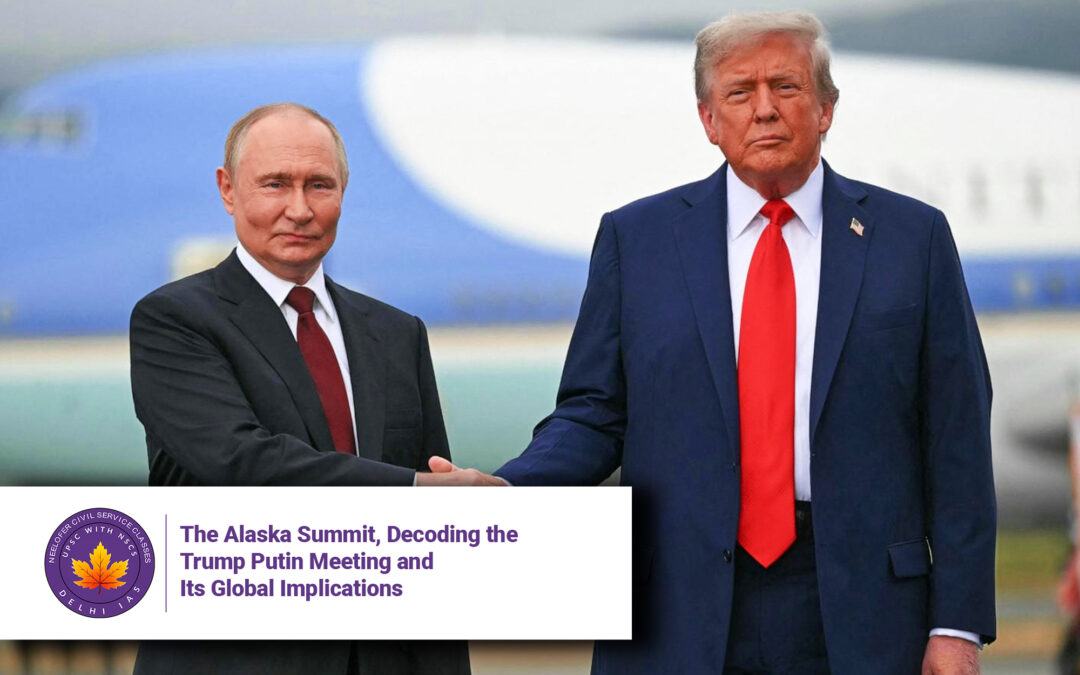The Alaska Summit, Decoding the Trump-Putin Meeting and Its Global Implications
Introduction
The recent high-stakes meeting between former US President Donald Trump and Russian President Vladimir Putin in Anchorage, Alaska, has sparked intense global scrutiny. While both leaders hailed the talks as “extremely productive,” the absence of concrete agreements raises questions about the summit’s actual geopolitical significance. This article provides a comprehensive analysis of:
-
Key outcomes and statements from the Alaska meeting
-
The strategic implications for the Ukraine conflict
-
How this summit fits into broader US-Russia relations
-
Potential consequences for NATO and European security
-
5 Key Q&A on the summit’s ramifications
The Alaska Summit: What Actually Happened?
1. The Meeting’s Structure and Participants
-
Location: Joint Base Elmendorf-Richardson, Alaska
-
Format:
-
Initial one-on-one planned, but expanded to 3v3
-
US side: Trump, Sec. Marco Rubio, Envoy Steve Witkoff
-
Russian side: Putin, FM Sergey Lavrov, advisor Yuri Ushakov
-
-
Private Discussion: 10-minute limo ride in “The Beast” (no interpreters)
2. Key Statements and Claims
| Leader | Notable Quote | Implication |
|---|---|---|
| Putin | “This war wouldn’t have happened under Trump” | Direct criticism of Biden’s Ukraine policy |
| Trump | “This is Biden’s war…we’re close to a deal” | Positions himself as peacemaker |
| Trump | “Now it’s up to Zelensky” | Shifts responsibility to Ukraine |
3. The “Understanding” vs. Reality
-
Putin referenced an “understanding” on conflict resolution
-
No written agreements or ceasefire announced
-
European leaders warned not to “torpedo progress”
Strategic Analysis: Winners and Losers
1. Trump’s Calculated Moves
-
Domestic Politics: Reinforces “I could’ve prevented war” narrative
-
Negotiation Tactics: Uses ambiguity to claim progress without commitments
-
Risk Management: Avoided being alone with Putin (3v3 format)
2. Putin’s Strategic Gains
-
Legitimacy Boost: Face-to-face with US leader despite sanctions
-
Narrative Control: Framed conflict as Biden’s failure
-
Division Sowing: “Europe shouldn’t torpedo progress” comment
3. Ukraine’s Precarious Position
-
Zelensky’s Dilemma:
-
Accept Trump’s framework? Risk territorial concessions
-
Reject it? Lose US support if Trump wins 2024
-
-
European Concerns: Fear of US-Russia deal bypassing Ukraine
Historical Context: US-Russia Summit Diplomacy
Comparative Analysis of Key Summits
| Summit | Year | Outcome | Parallels to Alaska |
|---|---|---|---|
| Reykjavik (Reagan-Gorbachev) | 1986 | No deal but set stage for INF Treaty | Showed value of “no agreement” summits |
| Helsinki (Trump-Putin) | 2018 | Controversial press conference | Similar accusations of US concessions |
| Geneva (Biden-Putin) | 2021 | Stable but unproductive | Contrasts with Trump’s transactional approach |
Global Reactions and Implications
1. European Security Concerns
-
NATO Anxiety: Potential US-Russia détente could weaken alliance
-
German/French Response: Calls for “European solutions”
-
Eastern Europe: Poland/Baltics increase defense spending
2. Impact on Ukraine War
-
Short-Term: No battlefield changes
-
Medium-Term:
-
Possible Trump-Zelensky pressure
-
Risk of frozen conflict
-
3. 2024 US Election Dynamics
-
Trump’s Campaign: “Peacemaker” vs. “Putin appeaser” narratives
-
Biden’s Counter: Accuses Trump of undermining Ukraine
5 Key Q&A on the Summit’s Ramifications
Q1: Why did the meeting happen in Alaska?
A: Symbolic neutral ground—close to Russia (53 miles from Diomede Islands) but US territory. Avoids granting Putin a prestigious US visit.
Q2: What could have been discussed in the 10-minute limo ride?
A: Likely topics:
-
Ukraine ceasefire parameters
-
NATO expansion limits
-
Potential oil/gas deals (Arctic drilling rights)
Q3: How does this affect Ukraine’s NATO aspirations?
A: Complicates them—Trump may have signaled openness to Russian “security guarantees” blocking Ukrainian membership.
Q4: Why include Marco Rubio (known Russia hawk) in talks?
A: Political cover for Trump—shows he’s not making unilateral concessions. Rubio’s presence reassures GOP skeptics.
Q5: Could this lead to a Trump-mediated peace deal before 2024?
A: Unlikely before US elections, but sets stage for potential 2025 deal involving:
-
Autonomy for Donbas
-
Crimea remaining Russian
-
NATO non-membership pledge
Conclusion: Theater or Turning Point?
The Alaska summit represents classic Trump-Putin diplomacy—high on symbolism but low on substance. While no agreements were signed, the meeting achieved:
For Trump: A campaign narrative as peacemaker
For Putin: Legitimacy and wedge between US-Europe
For Global Order: A preview of potential 2025 realignment
As Sridhar Krishnaswami notes, the true test lies in whether this “understanding” evolves into tangible action—or joins the long list of failed US-Russia resets. With Zelensky now pressured to negotiate and Europe sidelined, Alaska may be remembered as the beginning of a new, transactional phase in great power politics.
Author
Sridhar Krishnaswami
Senior Journalist & Former Washington DC Correspondent







